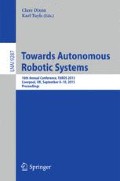Abstract
This paper presents a hybrid test method that enables the investigation of contact-impact scenarios in complex systems using kinematically versatile, off-the-shelf industrial robots. Based on the pseudo-dynamic test method, the technique conducts tests on an enlarged time scale, thereby circumventing control rate and response time limitations of the transfer system. An initial exploratory study of a drop test demonstrates that non-rate dependant effects including non-linear stiffness and structural hysteresis can be captured accurately while limitations result from the neglect of rate- and time-dependant effects such as viscous damping and creep. Future work will apply the new method to contact scenarios in air-to-air refuelling.
Access this chapter
Tax calculation will be finalised at checkout
Purchases are for personal use only
Preview
Unable to display preview. Download preview PDF.
References
du Bois, J.L., Thomas, P.R., Richardson, T.S.: Development of a relative motion facility for simulations of autonomous air to air refuelling. In: 2012 IEEE Aerospace Conference, pp. 1–12. IEEE (2012)
Du Bois, J.L., Newell, P., Bullock, S., Thomas, P., Richardson, T.: Vision based closed-loop control systems for satellite rendezvous with model-in-the-loop validation and testing. In: 23rd International Symposium on Space Flight Dynamics. University of Bath (2012)
Hogan, N.: Impedance control: an approach to manipulation. In: American Control Conference, pp. 304–313. IEEE (1984)
Ortega, R., Van Der Schaft, A.J., Mareels, I., Maschke, B.: Putting energy back in control. IEEE Control Systems 21(2), 18–33 (2001)
De Luca, A.: Feedforward/feedback laws for the control of flexible robots. In: Proceedings of the IEEE International Conference on Robotics and Automation, ICRA 2000, vol. 1, pp. 233–240. IEEE (2000)
Williams, M.S., Blakeborough, A.: Laboratory testing of structures under dynamic loads: an introductory review. Philosophical Transactions of the Royal Society of London. Series A: Mathematical, Physical and Engineering Sciences 359(1786), 1651–1669 (2001)
Author information
Authors and Affiliations
Corresponding author
Editor information
Editors and Affiliations
Rights and permissions
Copyright information
© 2015 Springer International Publishing Switzerland
About this paper
Cite this paper
Bolien, M., Iravani, P., du Bois, J.L. (2015). Robotic Pseudo-Dynamic Testing (RPsDT) of Contact-Impact Scenarios. In: Dixon, C., Tuyls, K. (eds) Towards Autonomous Robotic Systems. TAROS 2015. Lecture Notes in Computer Science(), vol 9287. Springer, Cham. https://doi.org/10.1007/978-3-319-22416-9_7
Download citation
DOI: https://doi.org/10.1007/978-3-319-22416-9_7
Published:
Publisher Name: Springer, Cham
Print ISBN: 978-3-319-22415-2
Online ISBN: 978-3-319-22416-9
eBook Packages: Computer ScienceComputer Science (R0)

